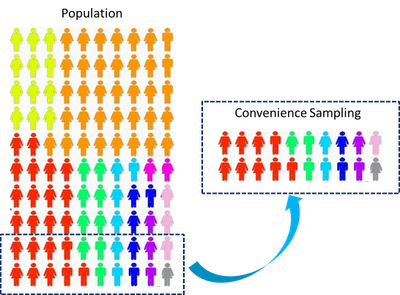Convenience sampling
Convenience sampling (also known as availability sampling) is a specific type of non-probability sampling method that relies on data collection from population members who are conveniently available to participate in study. Facebook polls or questions can be mentioned as a popular example for convenience sampling.
Convenience sampling is a type of sampling where the first available primary data source will be used for the research without additional requirements. In other words, this sampling method involves getting participants wherever you can find them and typically wherever is convenient. In convenience sampling no inclusion criteria identified prior to the selection of subjects. All subjects are invited to participate.
In business studies this method can be applied in order to gain initial primary data regarding specific issues such as perception of image of a particular brand or collecting opinions of perspective customers in relation to a new design of a product.
In its basic form, convenience sampling method can be applied by stopping random people on the street and asking questionnaire questions. ‘Pepsi Challenge’ marketing campaign can be referred to as a relevant example for this sampling method. ‘Pepsi Challenge’ is occasionally held in large shopping centres and other crowded locations and all members of population are invited to participate in the contest without any discrimination.
Convenience sampling technique may prove to be effective during exploration stage of the research area, and when conducting pilot data collection in order to identify and address shortcomings associated with questionnaire design.
Application of Convenience Sampling: an Example
The use of convenience sampling technique is discouraged by many dissertation supervisors due to inability to generalise research findings, the relevance of bias and high sampling error. Nevertheless convenience sampling may be the only option available in certain situations. For example, “it may be that an organisation you intend to use as a case study is ‘convenient’ because you have been able to negotiate access through existing contacts”[1].
Application of convenience sampling is the easiest compared to other sampling methods. Suppose, your dissertation is devoted on the following topic: A study into the sustainability of viral marketing as a marketing tool in the future.
Using convenience sampling method, you can send a link to the online questionnaire to individuals on your mobile phone’s contact list, to individuals you are connected to via social networking websites such as Facebook, LinkedIn, Google+ and to individuals whom you know in person. This would be the easiest and the most convenient way of recruiting the sources of the primary data for your research.
Advantages of Convenience Sampling
- Simplicity of sampling and the ease of research
- Helpful for pilot studies and for hypothesis generation
- Data collection can be facilitated in short duration of time
- Cheapest to implement that alternative sampling methods
Disadvantages of Convenience Sampling
- Highly vulnerable to selection bias and influences beyond the control of the researcher
- High level of sampling error
- Studies that use convenience sampling have little credibility due to reasons above
My e-book, The Ultimate Guide to Writing a Dissertation in Business Studies: a step by step approach contains a detailed, yet simple explanation of sampling methods. The e-book explains all stages of the research process starting from the selection of the research area to writing personal reflection. Important elements of dissertations such as research philosophy, research approach, research design, methods of data collection and data analysis are explained in this e-book in simple words.
John Dudovskiy
[1] Saunders, M., Lewis, P. & Thornhill, A. (2012) “Research Methods for Business Students” 6th edition, Pearson Education Limited


